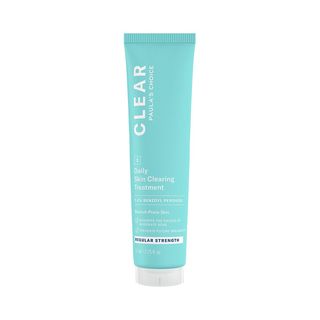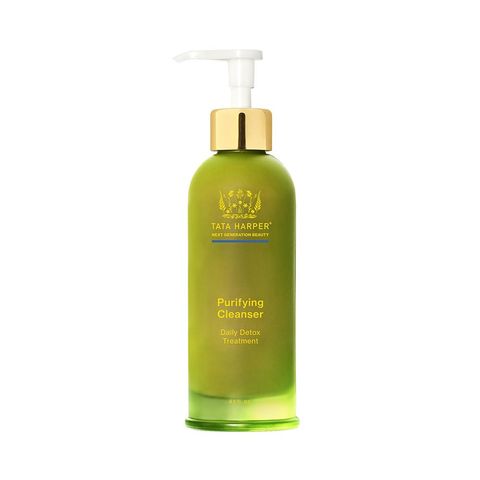When you wake up with a new (unwanted) pimple, it almost always appears on a day when you desperately don’t want to deal with it. Whether you’re heading to a job interview, wedding, or on a first date, an unexpected pimple is never welcomed. Googling quick remedies to minimize the pimple before popping it may give you some hope, but not as soon as you’d like.
The sad truth is that you can’t clear up a pimple in an hour, and even getting rid of one overnight can be a challenge. However, there’s no need to resort to popping. It’s possible to rid acne of its worst traits if you employ a diligent skincare regimen. “Pimples are small micro-infections of hair follicles,” explains Dr. Purvisha Patel, board-certified dermatologist and founder of Visha Skincare. “You may not be able to get ‘rid’ of a pimple overnight, but you can make it look a lot better, so it appears to be gone.”
Dr. Angela J. Lamb, director of the Westside Mount Sinai Dermatology Faculty Practice in New York City, adds that there are “no guarantees” when it comes to a bedtime miracle, but there are several steps you can follow to get your skin glowing just in time.
Read on for derm-approved tips to minimizing breakouts.
Make sure you’re using the right ingredients.
Stop staring at your pimple for a second and do a little research on it. Dr. Patel explains that pimples are commonly caused by four things: follicular occlusion, microbe growth, sebum production (or adding oil to your skin), and inflammation.
All these issues can be addressed when a pimple is in its early stage. “The most common way to address these issues is to use benzoyl peroxide, sulfur, tree oil, or salicylic acid products before you go to bed,” says Dr. Patel.
Benzoyl peroxide is a bleaching agent that kills microbes and dries up oil in the follicle.
Similar to benzoyl peroxide, tea tree oil and sulfur also work by drying up the pimple. “Using these products can make the pimple look smaller in the morning, ” explains Dr. Patel.
Dr. Lamb also recommends using prescription topical products, if you happen to have any in your medicine cabinet. Gels that contain clindamycin—an antibiotic—or topical minocycline can quickly reduce the appearance of an angry zit.
However, if you prefer to use products that don’t require a doctor’s note, Dr. Patel and Dr. Lamb both recommend trying salicylic acid first. “Salicylic acid products not only dry up the pimple and kill any microbes, but also exfoliate the skin on top to let any accumulated puss out of the follicle,” says Dr. Patel. (Gross, but effective.)
Wash with a quality cleanser.
Spot treatments and pimple patches get all the hype for acne emergencies, but don’t ignore the power of a good cleanser. You can find one imbued with the ingredients mentioned above—such as the Effaclar Medicated Gel Cleanser, which has two percent salicylic acid—or invest in another good exfoliating wash.
“Exfoliating cleansers are perfect for acne, as they help unclog the pores to not only treat pimples, but also prevent them from occurring,” says Dr. Patel. This gel-to-oil cleanser from Tata Harper purges impurities from pollution, giving you renewed, fresh-looking skin. It’s made from ingredients like vitamin P, white turmeric, African oil palm, sunflower seed oil, and white willow bark to detox skin, dissolve build-up, and refine pores.
If you’re getting desperate, try hydrocortisone cream.
Yes, it’s for more than just mosquito bites!
Dr. Patel says over-the-counter hydrocortisone cream can be a quick fix for redness, so long as you don’t use it for more than three nights in a row. Don’t layer it on too thick, either:
If you’re not careful, it may block your pores.
It’s best to find a hydrocortisone cream that is hyaluronic acid-based, as hyaluronic acid is a water-binding molecule that doesn’t clog pores.
As you’re treating, stay away from edible ingredients.
Products formulated with coconut oil, olive oil, or almond oil sound luxurious and healthy. When it comes to acne treatment, they’re only reinforcing the problem. Steer clear of edible ingredients if you’re in the midst of a pimple crisis.
“If we can eat the product, bacteria and fungus can eat the product,” Dr. Patel says, “and this could possibly make more pimples.”
Miracles can happen if you use a good spot treatment or pimple patch.
Dr. Lamb highly recommends putting a well-reviewed pimple patch on a problem area, as the treatment “usually cannot hurt.” Avoid overusing them, especially ones that contain acids or benzoyl peroxide, as they can create additional irritation.
When you’re in a bind, Dr. Patel prefers turning to spot treatments, which “work better for overnight fixes,” she says. “Blister bandages or hydrocolloid patches work by pulling the contents of a pimple out versus topicals that dry up the pimple.”
In case of an emergency, use cortisone injections.
If you have access to a dermatologist the day before your major event, it’s true you can get a cortisone injection to immediately treat your zit. But make sure you’re thinking seriously about the level of necessity.
“They are truly for a pimple emergency,” says Dr. Patel. “Think a day before your wedding or prom-level of emergency.” While steroid injections decrease inflammation of the pimple immediately, the side effects of steroid injections range from skin thinning to lightning to possible indentation at the injection site. They are NOT recommended as a regular pimple treatment.
If buying new products isn’t an option, try a DIY treatment.
It’s possible to stir up a great at-home acne treatment with a few ingredients in your kitchen. Try the following:
- A small crushed-up aspirin paste to a pimple helps with drying up the spot and inflammation.
- Toothpaste—the opaque kind, not gel—can be used to dry up pimples.
- Ice to a red pimple gives immediate blood vessel constriction and helps with redness.
- Conversely, you can use a warm compress to bring a pimple to a head faster, according to Dr. Lamb.
Believe it or not, popping can be an option. Just proceed with extreme caution.
If you’ve exhausted all your options, nothing has worked, and you’re hours away from walking down the aisle with a massive whitehead, it’s finally time to consider popping.
Dr. Lamb warns that squeezing a zit is normally a huge no-no. But if a pimple has a huge whitehead—and all its contents are visible at the top—you can use clean, gloved hands or cotton swabs to apply gentle pressure and pop. The problem, she explains, comes when you pop pimples that aren’t ready or squeeze with dirty fingers.
“Squeezing them with non-sterile fingernails can lead to spreading of the micro-infection, more inflammation, and scarring,” explains Dr. Patel. So, in most instances, it’s better to be safe than sorry.
This content is imported from {embed-name}. You may be able to find the same content in another format, or you may be able to find more information, at their web site.
Finally, trust your concealer.
Makeup was made for times like these. It’s possible to make a zit look nonexistent—even if it hasn’t disappeared entirely—if you invest in a quality concealer. Dr. Lamb loves Make Up For Ever’s concealer, or you can try a green concealer, which counteracts the redness of acne and inflammation. Either way, you’ll end up looking stunning—pimple or not.
This content is created and maintained by a third party, and imported onto this page to help users provide their email addresses. You may be able to find more information about this and similar content at piano.io







